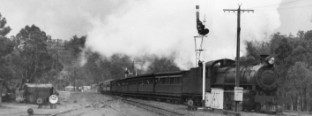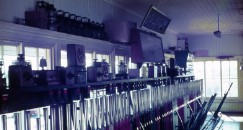54 Mile 25 Chain Block Box
Quick Facts |
|
Opened: 1926 |
Closed |
Interlocked: 1898 |
1966 |
Mechanical |
Electrical |
10 Levers |
Winters Block |
Fate: Unknown |
|
One of the few signal cabins on the WAGR system that was only ever identified by its mileage, the 54 Mile 25 Chain Box was, as it name indicates, located on the Eastern Railway 54 miles 25 chains from Perth. As the expression “54 miles 25 chains” was undoubtedly a mouthful the box was, throughout its life, more commonly known as the 54 ¼ Mile Box. This title, with its sensible rounding done to the nearest fraction description was not merely a colloquialism but an officially sanctioned name , having received the imprimatur of the compliers of the official Working time Tables and the Weekly Notices.
The 1920s saw the reopening of Mokine and Wundowie as block posts, and the establishment of a cabin at Koojedda. This was almost certainly done to reduce the headway , that is the time between one train travelling through a section and the next train when absolute Block Working is in use. This drive to operational efficiency over the Eastern Railway was probably due to the increase in wheat and superphosphate traffic moving over the line consequent on the opening up of the great Western Australian 'Wheat Belt'. Unlike today, when wheat can be stored at country siloes and railed to port at a leisurely and measured place, in the 1920s the transport of wheat from farm to port involved a frantic burst of activity for about half the year followed by a lengthy period of quietude. Operationally, this resulted in the opening of these locations on a seasonal basis, there being insufficient work to keep the staff at these boxes usefully employed all year round.
In 1925, the WAGR had plans to station a bank engine at Clacklline, in order to bank trains from Mokine to Baker's Hill. This would have enabled a single FS goods engine to haul a through load of 475 tons from Northam to Midland without the need to divide the load between Spencers Brook and Koojedda.
Crossovers were to be installed at Mokine, and installation of a Down Advanced Starting signal was seriously condidered, so as facilitate this working. The signal comittee even went as far as to travel to Mokine, complete with flags, poles and periscope to determine the best location for this signal, however this plan was to come to naught. In late 1925, the WAGR abandonded the plans to install the proposed crossovers at Mokine, deciding that the more favourable grades at the 54 mile and a quarter rendered that site a more suitable location. Accordingly, Mokine was closed in January 1925, and a new box, at the ex-Perth mileage of 54 and one quarter miles, was opened in lieu.
The 54 ¼ Mile Box was opened on the 7th January 1926. It was a block post located roughly half way between the important stations of Clackline and Spencers Brook. It was located about a mile to the west of Mokine. Although the box replaced Mokine as block post it did not supplant it as a siding; Mokine co-existing with the box for its entire life. Had the 54 ¼ Mile Box totally replaced Mokine it is possible that it may well have assumed Mokine’s name, the WAGR being a recycler of names as well as equipment.
The 54 ¼ Mile Box was located on a long straight on a relatively level section of track, the grade through the location being 1 in 200; a welcome respite from the succession of stretches of 1 in 50 and 1 in 60 grades that taxed Up trains banked or otherwise - climbing towards Koojedda. To date the author has not been able to determine if a bank engine was ever stationed at Clackline. The only evidence located indicates that the old practice of banking trains utilising Northam based locomotives was retained, leading one to wonder how often - if ever - the crossovers were used.
The box worked with Clackline to the West and Spencers Brook to the East, using Winters Two-position Block instruments. The signalling arrangement at the box was very simple, consisting of an Up Distant, an Up Home, a Down Distant, a Down Home and an unsignalled crossover, the points trailing to the normal direction of travel on each main. All signals and points were worked from a six lever ground frame located on the south side of the track. A box of some description was undoubtedly provided: signalmen may have been waterproof but block instruments were most certainly not, and needed protection from the elements. The ability to separate block instruments and signal levers was a feature of Winters Two-position Block instruments: unlike Sykes Lock and Block instruments there was no interconnection "with the fixed signals controlling the entrance into the section ahead" as the Rule Book stated. This facility enabled smaller and less expensive cabins to be used, something which was probably appreciated by the WAGRs accounting branch far more than the staff that had to work them. Precisely what the box looked like is not known: to date no plans or photographs of the box have been located. The abovementioned signalling diagram shows the location of the frame only. Given the financial straits in which the WAGR found itself during the 1920s it is quite possible that the cabin may have been a simple weatherboard hut similar to the first box at Koojedda. If so, it is conceivable that the box was to have been subsequently replaced with a standard box; the author’s discussions with drivers based at Northam in the 1950s indicate that the box was, at that stage, probably a standard WAGR corrugated iron and weatherboard box similar in style to Karrijine, Tunnel Junction and Carlisle.
Like Wundowie, insomnia was probably a perquisite that a Safeworking porter had to demonstrate before being eligible for a posting to the 54 ¼ Mile Box. Weekly Notice 2 of 1926 advised that Train Numbers 7 and 8 could stop at the box to pick up or set down employees. As No. 7 (the East-bound Albany express) was timetabled through Mokine at 6.58 pm (Saturdays excepted) and its West-bound counterpart No. 8 passed Mokine at 8.06am (except Mondays) one can reasonably infer that the box worked predominantly night shifts. The 1927 Working Time Table gave the hours of operation as 5.00 pm to 7.40 am Tuesday to Friday, 5.00 pm to Midnight Saturday, while the lucky Signal Porters working the box on Mondays worked a more civilised shift from 3.00 pm to 10.20 pm. Whether by this stage the staff were required to travel to the box, or were provided with accommodation on site is not now readily apparent, although the lack of any Down trains which would have stopped at the box between 2.00 pm and 5.00 pm most days suggests that the latter was a possibility.
During the 6 years following its opening the 54 ¼ Mile Box was to be opened and closed with monotonous regularity, the openings and closures roughly coinciding with the annual wheat harvest. Each such closure and opening was duly reported in the Weekly Notices, most closures occurring in May with re-opening typically occurring in December. One feature of some (although by no means all) of the closures was the spiking of the crossovers. The reason for this intermittent spiking is not known: perhaps the WAGR had varying opinions as to the effectiveness or integrity of its interlocking when boxes were closed. In June 1932, the box was closed and the staff withdrawn. This closure coincided with the withdrawal of the Assistant Station Master at Bakers Hill, these closures probably being part of a Depression-era cost cutting exercise. As was the case with the withdrawal of the Bakers Hill ASM, closure of the box caused some difficulties with the movement of stock trains on Tuesday nights, and so a Safeworking porter was directed to travel to the 54 ¼ Mile Box on Train No. 112 and open the box to allow for the movement of these trains. This is seasonal closure is not recorded as being mirrored by an opening later that year, or, for that matter, any year. However, the box clearly remained open and in use, several references in the weekly notices during the late 1930s and the early 1940s referring to trains stopping at the box to pick up staff, school children and passengers point to the box's ongoing existence and / or use. The box probably saw an upsurge in use during the Second World War, playing its part in the movement of unprecedented numbers of passengers and wartime traffic that, at times, taxed the eastern Railway to the very limit.
Post war, the 54 ¼ Mile Box appears to have led an uneventful life, never causing the WAGR administration enough trouble to require an operational entry in the Weekly Notices until 1960. In July of that year, Weekly Notice 26 of 1960 announced that the crossover road had been removed, while a fortnight later Weekly Notice 28 of 1960 advised that the box and signals had been removed, as the long awaited introduction of automatic double line signalling from Koojedda to Spencers Brook had been opened.
The Automatic colour-light signalling that replaced the Winters two position block working was to survive the closure of the 54 ¼ Mile Box by less than 6 years. In February 1966 the old Eastern railway was closed between Wundowie and Bellevue, replaced by the new Avon Valley Line. For the next 15 years trains continued to run between Spring Hill and Wundowie to service the pig iron plant at the latter location, however, none of the old stations or boxes between Koojedda or Spencers Brook were to play any part in the operation of these services.
Today no trace remains of the 54 ¼ Mile Box remains. The trackbed has vanished beneath a road, with even the bases of the automatic signals buried or moved in the process of its construction. The only indication that there has ever been a facility there is a clump of sugar cane, probably planted by a signal porter to provide a sweetener for the hot cups of tea which, no doubt, were both a necessary adjunct to working the ground frames at this location on many a chilly autumns night and a useful debating tool when discussing the relative merits of Winters instruments.
Any additional information on this signal cabin would be most welcome - please use the e-mail form provided on this page.
Information researched and interpreted by Justin Smith of the Signalling Interest Group of W. A.
Last updated by the Author 28/06/2015
Diagram of Signalling by WAGR courtesy of Rail Heritage WA Archives
This page is copyright, and permission must be sought from SignallingWA before this page is used for any purpose other than personal education.
54 1/4 MILE BOX Employees | ||
This list may not be complete and does not yet include employees who worked here without being appointed. Where an appointment date is unknown, the Weekly Notice (WN) date advising of the appointment or other official documentation, i.e. Certificate of Competency (CC) will be used. | ||
Name | Appointed | Position |
Is a name missing? Please submit any corrections / additions with suitable evidence using the e-mail form above. | ||


